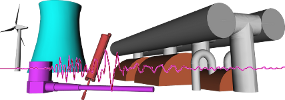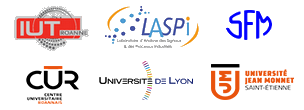Contest rules
- Contestants are invited to contact the Scientific Committee (jerome.antoni@insa-lyon.fr) to obtain the data.
- Contestants are expected to send 1) a short report in electronic format (pdf file), 2) the requested data (in .txt or .mat) and 3) a maximum of 3 slides (pdf file) that summarize the report to jerome.antoni@insa-lyon.fr before October 19, 2015, 08:00am (Paris time).
- The submitted report should contain a description of the methodology followed by the contestants and a presentation of the obtained results.
- Evaluation of the results will be based on criteria defined hereafter in the exercises.
Presentation of the contest
The contest comprises two independent exercises. Contestants are encouraged to answer the two questions, but answers to one of the two questions only will also be considered.
The system under analysis is a gearbox whose kinematics is summarized in Fig. 1 and Tab. 1.

Figure 1: Kinematics of the gearbox

Table 1: Characteristic frequencies of the gearbox referenced to HP shaft rotating speed (N2)
|
|
L1
|
L4
|
L5
|
|
Outer race
|
4.066
|
4.030
|
7.759
|
|
Inner race
|
5.934
|
5.970
|
10.241
|
|
Rolling element
|
2.584
|
2.480
|
3.556
|
|
Cage
|
0.407
|
0.403
|
0.431
|
Table 2: Fault frequencies of bearings supporting shafts L1, L4 and L5 referenced to shaft rotations L1, L4 and L5, respectively
Exercise 1
The objective of this exercise is to recover the nonstationary rotation speed of HP shaft (N2) from a vibration signal mounted on the gearbox casing.
Data in file (Data1_Surveillance8):
- Sampling frequency = 50kHz
- Record duration: 3.4 minutes
- Track 1: vibration signal ‘Acc0’. Contains visible harmonics from HP shaft (N2 associated to order 1 in Table 1)
Objective:
- Estimate as accurately as possible the (nonstationary) rotation speed N2 from the vibration signal.
Deliverable:
- The rotation speed N2 is to be returned as a signal (format .txt or .mat) in Hz with the same time axis as for the original vibration signal.
Criteria of evaluation:
- Median and mean absolute deviations from the true rotation speed N2 returned by the tachymeter (not provided).
- Ability to reconstruct high-frequency speed fluctuations.
- Given identical results, the simplest and most original approach will be preferred.
Exercise 2
The objective of this exercise is to detect a fault in one or more of the three bearings supporting shafts L1, L4 and L5 from vibration signals mounted on the gearbox casing.
Data in file (Data2_Surveillance8):
- Sampling frequency = 50kHz
- Record duration: 3.4 minutes
- Track 1: signal ‘tacho’ from tachymeter mounted on shaft L4 (see Fig. 1). Resolution = 44 pulses per revolution
- Track 2: vibration signal ‘Acc1’ recorded simultaneously with the tachymeter
- Track 3: vibration signal ‘Acc2’ recorded simultaneously with the tachymeter
Objectives:
- Task 1: As an intermediary step, it is asked to estimate the rotation speed of shaft L4 from the tacho signal as accurately as possible.
- Task 2: Detect the bearing fault.
Deliverables:
1) Rotation speed of shaft L4 as a signal (format .txt or .mat) in Hz with the same time axis as for the original signals.
2) Proof of detection of the bearing fault(s) in the form of a signal (time or angle), a spectrum (frequency or order), or any other representation that
- maximally emphasizes the fault signature(s) with respect to background noise,
- identifies the fault origin(s) without ambiguity.
Criteria of evaluation:
Task 1: estimation of rotation speed
- median and mean absolute deviations from the true rotation speed N2,
- ability to reconstruct high-frequency speed fluctuations.
Task 2: bearing fault detection
- contrast between extracted fault signature(s) and background noise,
- ability to clearly identify the fault origin(s),
- given identical results, the simplest and most original approach will be preferred.
Contest Regulations
- The competition will run from October 1, 2015 until October 20, 2015.
- Contestants may be individual persons or teams of persons.
- Competition is open to participants who registered for the conference. Deadline for registration is October 20, 2015.
- Participation to the contest is conditioned to registration and attendance to the conference.
- Contestants are expected to send 1) a short report in electronic format (pdf file), 2) the requested data (in .txt or .mat) and 3) a maximum of 3 slides (pdf file) that summarize the report to jerome.antoni@insa-lyon.fr before October 19, 2015, 08:00am (Paris time).
- The report must comply with the requirements of the contest rules.
- Winners will be chosen by a Jury composed of members of the Organizing Committee, Scientific Committee, and SAFRAN.
- Prizes can only be given to contestants who will attend the conference.
- First prize is 3000€, second prize is 2000€, and third prize is 1000€.
- Contestants are supposed to follow a code of ethics. This implies no acquaintance with the data used in the contest. Employees or subcontractors (including academics) of SAFRAN may not be eligible to participate. (Please contact the Jury members if you have question regarding this point)
- Participation to the contest may possibly be invalidated if it happens that the contest regulations have not been met.
- By participating, all contestants acknowledge and agree that they have entered the contest of their own free will, that the full rules and details of the contest have been made available to them in writing and they therefore understand and agree that the organizers have any liability with respect to any damages out of acceptance and use of a prize.
Usage of data
Data provided in the contest will become publicly available after October 21, 2015. Subsequent use of the data is allowed only for scientific research. Any publication that will result from subsequent use of the data must reference the “SAFRAN Contest, Conference Surveillance 8, October 20-21, 2015, Roanne, France”.
 Download PDF Version
Download PDF Version







